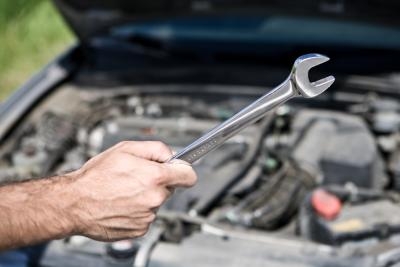
Nissan used the KA24E engine in several models of automobiles, including the 240SX. The head gasket forms a seal between the cylinder head and the block. It seals off the cylinders to ensure maximum compression so that the engine can operate efficiently. When the head gasket fails, the engine cannot maintain this compression. Another problem when the head gasket fails is that it allows oil and coolant to mix, which can create further damage to the engine.
Turn the crankshaft clockwise with a wrench until the number one cylinder is at top dead center of the compression stroke. This is evident when the timing mark on the crankshaft pulley lines up with the mark on the engine block. Disconnect the negative cable from the battery using a wrench. Open the valve on the bottom of the radiator with a wrench and drain the engine coolant. Set the coolant aside for recycling at an approved center.
Disconnect the radiator and heater hoses using a screwdriver to loosen the hose clamps. Remove the bolts from the alternator using a socket and ratchet. Move the alternator off to the side. Remove the bolts from the AC compressor using a socket and ratchet, but do not disconnect the refrigerant lines. Position the compressor off to the side. Remove the power steering pump using a socket and ratchet. Label the spark plug wires with a marker and masking tape.
Disconnect the spark plug wires by grasping the boot and pulling each one off. Remove the spark plugs with a socket and ratchet. Do not pull by the wire itself or you will damage it. Disconnect the throttle linkage from the throttle body. Disconnect the air intake hose using a screwdriver to loosen the clamp. Relieve the fuel pressure by opening the valve on the fuel rail. Disconnect the fuel and fuel return lines using a wrench. Plug the lines with fuel plugs.
Label the vacuum line and electrical wires at the cylinder head using a marker and masking tape. Disconnect the wires and vacuum lines from the cylinder head. Remove the EGR tube from the back of the engine. Remove the exhaust induction tubes from the manifold. Unbolt the exhaust pipe from the manifold using a wrench. Remove the PCV valve from the back of the engine. Disconnect the ground harness from the valve cover if one is present.
Remove the bolts from the valve cover using a socket and ratchet. Lift the valve cover away from the cylinder head. Mark the relation of the camshaft sprocket to the timing chain using a paint pen. This will prevent having to find the factory marks later. Secure the timing chain with a wire tie so that it does not fail into the engine when you remove the camshaft sprocket.
Remove the bolts from the camshaft sprocket using a socket and ratchet. Remove the cylinder head bolts with a hex socket and ratchet. Starting from the ends, and working your way in remove first from one end and then the other. Lift the cylinder head away from the engine block. Remove the gasket and discard it.
Take the cylinder head to an automotive machine shop to have it resurfaced. Clean the engine block thoroughly and then place the new gasket on the block facing up. Do not use any type of gasket sealant on the head gasket. Place the gasket on the engine block and line it up with the dowel pins. Temporarily torque the right and left center head bolts to 14 foot-pounds with the torque wrench.
Install the camshaft sprocket and make sure the marks line up. Install the bolt and tighten it with a socket and ratchet. Install the remaining cylinder head bolts. Torque all of the bolts to 20 foot-pounds on the first pass in an X-pattern. Tighten the bolts to 40 foot-pounds on a second pass and then 58 foot-pounds on the final pass. Install the spark plugs and tighten them with a socket and ratchet. Install the valve cover and gasket. Tighten the bolts with a socket and ratchet.
Connect the PCV valve at the back of the engine. Connect the exhaust pipe to the manifold and tighten the bolts with a wrench. Connect the exhaust induction tubes to the manifold. Connect the EGR tube at the back of the engine. Connect the throttle linkage to the throttle body. Connect the air intake hose and tighten the clamp with a screwdriver. Connect the fuel and fuel return lines. Connect the vacuum lines and electrical wires at the cylinder head.
Install the power steering pump and tighten the bolts with a socket and ratchet. Install the AC compressor and tighten the bolts with a socket and ratchet. Install the alternator and bracket. Tighten the bolts with a socket and ratchet. Connect the radiator and heater hoses. Tighten the hose clamps with a screwdriver. Refill the cooling system with fresh cooling through the radiator and reservoir.